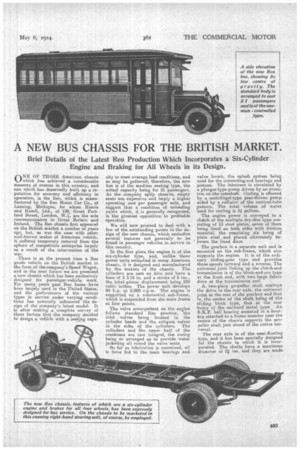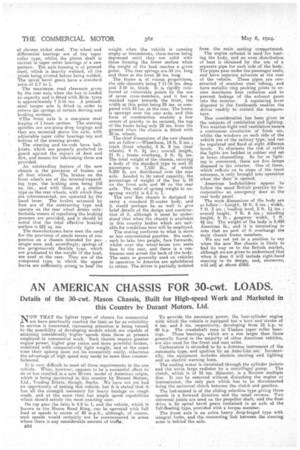A NEW BUS CHASSIS FOR THE BRITISH MARKET.
Page 9

Page 10

If you've noticed an error in this article please click here to report it so we can fix it.
• Brief Details of the Latest Reo Production Which Incorporates a Six-Cylinder Engine and Braking for All Wheels in its Design.
ONE OF THOSE American chassis which has achieved a considerable measure of success in this country, and one which has deservedly built up a reputation for economy and efficiency in operation; is the Reo, which is manufactured by the Rao Motor Car Co., of Lansing, Michigan, for whom Harris and Hasell, Ltd., of 130, Great Portland Street, London, W.1, are the sole coneessionnaires in Great Britain and Ireland. The Reo chassis first appeared on the British market a number of years ago, but, as was the ease with other well-known makes of American vehicle, it suffered temporary removal from the sphere of competitive enterprise largely as a result of the intervention of the war.
There is at the present time a Reo goods vehicle on the British market in the form of thecompany's Speed Wagon, and in the near future we are promised a new chassis which has been exclusively designed for passenger-vehicle work. For many years past Reo buses have been largely used in the United States, and the performance of the various types in service under varying conditions has naturally influenced the design of the eempanes latest model. It is after making a complete survey of these factors that the company decided to design a vehicle with a seating caps city to meet average load conditions, and as may be gathered, therefore., the new bus is of the medium seating type, the actual capacity being for 21 passengers. As the company aptly observe, empty seats are expensive and imply a higher operating cost per passenger mile, and suggest that a condition of unloading exists which, it is generally recognized, is the greatest opposition to profitable operation.
We will now proceed to deal with a few of the outstanding points in the design of the new chassis, which embodies several features not generally to be found in passenger vehicles in service in this country.
In the first place the engine is of the six-cylinder type, and, unlike those power units embodied in many American chassis, it is designed and manufactured by the makers of the chassis. The cylinders are cast on bloc and have a bare of 3 3-16 in. and a stroke of 5 ins., the total-piston dispiacement being 239 cubic inches. The power unit develops 50 hip; at 2,000 r.p.m. The engine is supported on a substantial sub-frame, which is suspended from the main frame
at four points.
The valve arrange-silent on the engine follows standard Bee practice, the inlet valves bein.g, located in the cylinder heads and the exhaust valves in the sides of the cylinders. The cylinders and the upper half of the crankcase are cast integral, the coring being so arranged as to provide water jacketing all round the valve seats.
So far as lubrication is concerned, oil is force fed to the main bearings and valve levels, the splash system being used for the connecting-rod bearings and pistons. The lubricant is circulated by a plunger-type pump driven by an eccentric on the camshaft. Cooling is effected by a centrifugal-type gear-driven pump aided by a radiator of the vertical-tube pattern. The total volume of water used for cooling is 34 gallons.
The engine power is conveyed to a clutch of the multiple dry-disc type consisting of 13 steel plates, seven of them being lined on both sides with friction. material, the remaining six being of plain steel and placed alternately between the lined discs.
The gearbox is a separate unit and is mounted on the sub-frame, which also supports the engine. It is of the ordinary sliding-gear type and provides three speeds forward and a reverse. The -universal joint linking up the clutch and transmissien is of the block-and-pin type at. the front end, with two large fabric discs at the transmission end.
A, two-piece propeller shaft .coriffeys the drive to the rear axle, the universal joint at the rear of the gearbox and that in, the centre of the shaft, being of the siding block type, that at the rear lacing, of the enclosed metal type. An 8.K.F. ball bearing mounted in a haus. ing attached to a frame member near the centre of the chassis supports the propeller shaft just ahead of the centre uni"rersal.
The rear axle is of the semi-floating type, and it has been specially designed for the chassis in which it is incorporated. The shafts have a maximum• diameter of 21 ins, and they are made
of chrome nickel steel. The wheel and differential bearings are of the taper roller type, whilst the pinion shaft is carried in taper roller bearings of a new pattern. The axle housing is of pressed steel, which is heavily webbed, all the joints being riveted before being welded. The spiral bevel gears have a standard ratio of 5.7 to 1. • The maximum .road clearance given by the rear axle when thesbus is loaded to capacity and is fitted with 30-in. tyres is approximately 7 3-16 ins. A pressedsteel torque arm is fittedin order to relieve t.he springs of certain driving and braking stresses. • Sl'The front axle is a one-piece steel forging of I-beam section. The steering spindles are one-piece drop forgings and they are mounted abOve the axle, with adjustable taper roller bearings top and bottom of the steering pivots.
. The steering and tie-rods have balljoints, which are properly protected to guard against the ingress of dust and dirt, and Means for lubricating them are provided. • An outstanding feature of the new chassis is the prevision Of brakes on
all four., wheels. The brakes on the front wheels are of the internal-expanding .type, the braking area being 103 sq, ins.,, and with those. of as similar. type on the rear wheels, with which they are interconnected, are operated by the hand lever. The brakes actuated by foot are of the contracting type and operate on the rear -wheel drums only.Suitable means of equalizing the braking pressure are provided, and it should he noted that 'the total effective braking' Surface is 621 sq. ins.
The manufacturers have seen the need f or the provision of ample means of sus, pension on a chassis intended for passenger uses, and, accordingly, Springs of the progressively flexible type, which are graduated to the weight of the load, are used at the rear. They are of the compound type, in which the upper leaves are sufficiently strong to bear. the weight when the vehicle is running empty or thereabouts, these leaves being depressed until they are solid with those forming the lower section when the weight of the load reaches a given point. 'The rear springs are 54 ins, long and those at the front 38 ins. long.
The frame is of robust proportions, the Side channels being 7 11-16 ins, deep and 3-16 in. thick. It is rigidly reinforced at vulnerable points by the use of seven cress-members, and it has a marked taper towards the front, the width at this point being 29 hiss. as °simpered with 43 ms, at the rear. The frame is upswept over the rear axle, and this form of constriction enables a low centre of gravity to be secured, the top of the frame being only 22 ins, from the ground when the chassis is fitted with 30-in. wheels.
The chief dimensions of the new chassis are as follow i—Wheelhase, 14 ft. 8 ins.; track (front wheels), 4 ft. 8 ins. (rear wheels). 4 ft. 91 Ins; overall length, 21 ft.; frame overhang, 3 ft. 9S ins. The total weight of the chassis, carrying a 'body of the standard type' to'seat 21 passengers is 7,150 lb., of which 4,200 lb. are distributed aver the rear axle. Loaded to its rated capacity, the
percentage of weight of the bug IA on the front axle and 84 on. the rear. axle. The ratio of sprang weight to unsprang weight is .6.5 to 1. . The new Reif chassis is designed to carry a standard 21-seater body, 'and it would perhaps be as well to give' brief details: of the design and construe, tints of it, although it must lie understood that When the chassi-is available in this county bodies which are' suit; able for conditions here will be employed..
The seating 'conforms to what is more or less conventional practice. Six seats, each to take two people; face forwards, whilst over 'the wheel-boxes tWo seats face to the rear, and there is a con: tinuous seat across the back of the body. The seats as generally used on vehicles in operation in America are upholstered is rattan. The driver is partially isolated from the main, seating compartment. The engine exhaust is used for heating the body, and an even distribution
of heat is obtained by the use of a separate pipe for each side of the body. The pipes pass under the passenger seats, and have separate exhausts at the rear of the vehicle. These pipes are con
structed of seamless steel tilting, and have metallic ring packing joints to en.
sure maximum heat radiation and to prevent leakage of the exhaust gases into the interior. A regulating lever disposed in the footboards enables the driver readily to control the temperature, Due consideration has been given to the subjects of ventilation and lighting.
Two weather-tight roof ventilators ensure a continuous circulation of fresh air, whilst the windows on each side of the vehicle ire of the railway type; and can
be regulated and fixed at eight :different levels.. To eliminate the risk of rattle
the lights are bedded in rubber and set in brass channelling. So far as lighting is esincerned, there are .five -lamps
disposed in the interior. One of, these, which reflects. on to steps of, the front entrance,. is only brought into operation when' the doer is opened. , American bodybuilders' appear to follow the usual' British .praaiee 'by 'MCorp-era-tine an emergency 'door .In the'
rear body panel. • • s• .• The main dimensions of tile body are as follow :—Length, 16 ft. Sins.; Width, 7 ft.'3 leading level, 2 ft. 11 ins.; Overall height, 7 ft. 6ins.'; 'standing height, 6 ft.; gangway "width', 1 ft. 4i ins: The weights of the body is 3,400! American lb.; and it is interesting to note that no part of -it overhangs the' Main chassis' frame Members.
• We are not yet .in a poeition to say when the new Reo chassis is likely to find its Way on to' the British Market, although we are givento understand that when it does it will include right-hand steering in its design, and, moreover, will Sell at about £565.


































